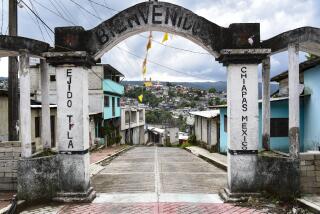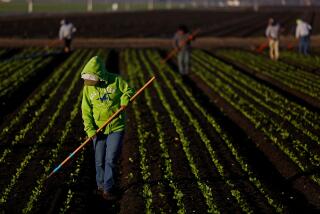GLOBAL AGRICULTURE : Land Reform : Guatemala Plagued by Historic Inequity : Fewer than 3% of the farms cover more than 65% of the farmland. The agrarian economy offers peasants few alternatives.
- Share via
ALTA VERAPAZ, Guatemala — Luis Choc should be working in the fields for the coffee harvest that begins in earnest next month on this farm in the hills 150 miles north of Guatemala City.
But he and 53 other hands have been fired for demanding that they receive the minimum wage. Choc, 40, and his family have lived here for generations: “It is where the bones of my ancestors are buried,” the Keqchi Maya community leader says.
From his house, Choc can see the electricity cable that runs through the farm--the Finca Pachilha--to operate the machinery that washes the coffee berries. But there is little prospect that the community’s small wooden huts, with earth floors and palm-leaf roofs, will be connected to the power line.
The barefoot Mayan children, their bellies bloated with parasites, can no longer go to classes because the landowner turned the schoolhouse into a dormitory for seasonal migrant workers.
Choc and the other regular workers on the farm do not own land and have depended for generations on the patronage of the landowner for the privilege of tilling small plots of corn to supplement their subsistence wage. This year, they do not know how they will survive.
The minimum wage is 11.20 quetzales a day, about $2. When they were dismissed by the owner more than a year ago, they were earning around 5 quetzales. “There are some farms where the workers are not paid at all,” said Antonio Argueta, a lawyer who is representing the workers in their wage claim against the owner.
These basic living conditions, which have barely changed for decades, are the result of Guatemala’s notoriously skewed distribution of land, a pattern whose roots lie in the need of the coffee-exporting elite for cheap labor and extensive holdings.
They date from the reforms of the “Liberal Revolution” of Gen. Justo Rufino Barrios in the 1870s, which are still a subject of heated debate. For some Guatemalans, the period was a comparative golden age of economic development that pulled the country out of stagnation at a time when the important market for cochineal, a dye extracted from insects, was collapsing. But others call the period one of consolidation of an authoritarian state alien to the interests of Guatemala’s indigenous peoples.
“The state elaborated a series of policies whose fundamental objective was to facilitate the cultivation of coffee,” said Gustavo Palma, a land historian at the University of San Carlos in Guatemala City. “What the Liberals wanted was to open the door for landowners with a modern coffee-exporting vision while restricting the possibilities for indigenous development.”
The government passed laws approving the appropriation of unused communal lands, which obliged the peasants to work on coffee plantations for subsistence wages. The results have stunted the growth of an internal economy, fueled social conflicts and contributed to rampant deforestation and migration to urban centers.
When left-wing guerrillas re-emerged in Guatemala in the mid-1970s they promised that, once they defeated the government forces, they would redistribute land that had historically belonged to indigenous communities. It was one of the most beguiling reasons for their widespread support in the countryside.
According to the most recent data, from a 1979 national census, fewer than 3% of the country’s farms cover more than 65% of its farmland. The problem is not the unequal distribution of land per se, analysts say, but the unequal distribution in an agrarian economy with very few alternatives. Unemployment and underemployment in the cities is approaching 50%, in part because Guatemala has failed to develop a substantial internal market.
By official estimates, 80% of Guatemalans live in poverty, and the figure is considerably higher in the countryside.
Since there are few alternatives, the limits on access to land have led to chronic poverty and inappropriate land use. In the highlands the ever-growing population is pushing farther up the mountains, chopping down trees to plant corn.
Meanwhile, the Keqchis are hacking ever deeper into the jungles of the Peten in the north, considered by many the second most important rain forest, after the Amazon, in the Western Hemisphere.
Environmental groups say that at the current rate of deforestation the whole of the Peten will disappear by 2050.
“You have this very distorted situation where you have a lot of latifundios (agricultural estates) underutilized or lying completely fallow while a lot of landless peasants are chopping down trees to plant corn on completely inappropriate lands--either mountain lands in the highlands or the very fragile lands in the jungle,” said one land expert who requested anonymity.
“Meanwhile, some of the best land is not being used at all or being used for cattle, which is low-intensive and does not provide a high return or create employment.”
While many analysts say that logic calls for some kind of land reform, the suggestion is fraught with highly charged political problems.
Any debate is colored by the divisive effect of the Agrarian Reform Law of 1952 during the radical government of Jacobo Arbenz. Arbenz expropriated, with compensation, large tracts of underutilized land, much of which belonged to the U.S.-owned United Fruit company. He was toppled in a CIA-backed coup, ushering in decades of right-wing leadership during which land reform has been a taboo subject.
As Arbenz himself said at the time, the 1952 reform “drew a line in the sand.” The stated intention was to attack “feudalism” and “develop the capitalist rural economy and the capitalist agricultural economy in general.”
“The reform unleashed a ferocious social conflict which has stigmatized the subject of land,” said Luis Alberto Reyes Mayen, president of the Chamber of Agriculture, which represents many large landowners. “For the left, land reform was what was needed to resolve the country’s problems; for the right, to lose the battle over land was to lose the ideological battle.”
Advocates of distributive land policies and fairer treatment of farm labor have been branded communists and sympathizers of left-wing guerrillas. Olayo Perez, a Quiche Maya who heads a campesino , or peasant farmer, organization, says the situation is growing more critical, leading to more land invasions and conflicts.
“If the landowners, the army and the government don’t sit down and develop agricultural programs to hand over land, it will be difficult to avoid a social explosion,” he said. “A new policy of distribution of land is urgent.”
That does not seem likely. Through the National Institute for Agrarian Transformation and Fonatierra, a land fund, the government has provided credit to campesinos to buy some land that it has acquired from larger landowners, following a model developed by the Fundacion Centavo (Fundacen), a Guatemalan non-governmental organization. Fundacen buys farms, divides them into three-hectare plots and resells them to campesinos.
The idea of selling land to peasants is no longer considered as subversive as it was 10 years ago when Fundacen was set up, but these programs will always be inadequate while the prevailing structure remains, analysts say.
The issue of land is to be discussed later as part of peace talks between the government and leftist guerrillas.
More to Read
Sign up for Essential California
The most important California stories and recommendations in your inbox every morning.
You may occasionally receive promotional content from the Los Angeles Times.










